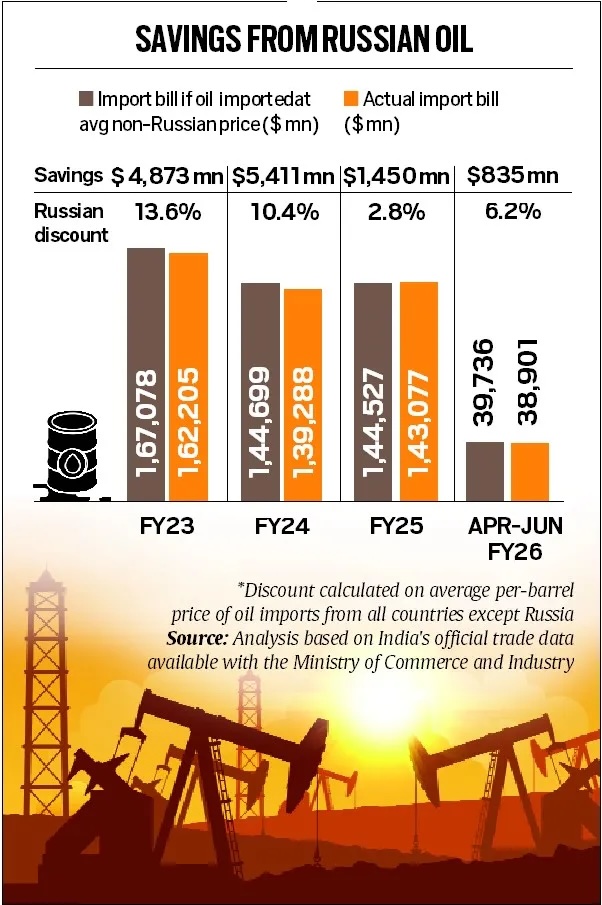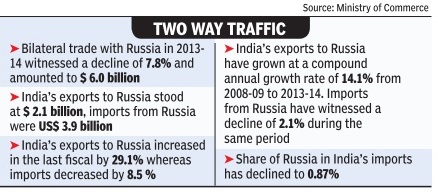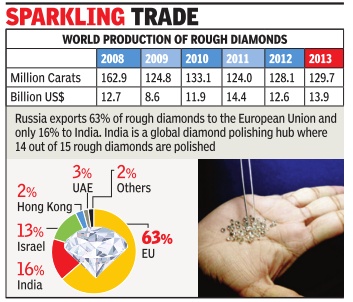Russia- India trade relations
This is a collection of articles archived for the excellence of their content. |
Contents |
Diamonds
India and Russia diamond deals
December 10, 2014
Both sides stand to gain from greater cooperation in diamond. Russia, facing global sanctions over Ukraine, has the opportunity to help India emerge as a key diamond-trading hub and an alternative to European centres.
India is the world's largest manufacturing hub for cut and polished diamonds, accounting for 60% of global supply on value and 85% in volume. Employing nearly 1million workers, she has skilled manpower to expand business.
The diamond business will emerge as a major source of lending for Indian banks whose exposure in Belgium, a key diamond trading centre, was about $1.5 billion.
“Moscow is a natural partner. We are trying to bring Russian business to India. Now Russian rough diamond comes to India via Belgium and Dubai. Once they start sending them here directly, it'll reduce our transaction costs,“ says Vipul Shah, chairman Gem and Jewellery Export Promotion Council.
Russia is the largest diamond producing country in terms of volume and in 2013 it produced 25% of total car ats and 26% of overall rough diamond. Industry data shows India imports roughly 90% of rough diamonds from the European Union, Israel and UAE. Only about 10% Indian imports come from Russia, Australia, Canada and Africa.
Russia exports 63% of rough diamonds to EU and 16% to India which is a global polishing centre. Industry officials point to the potential that exists for raising business levels.
Shah says Russia is expected to sign 12 long-term contracts with Indian companies during Putin's visit.He says several factors demonstrate that India and Russia can deepen their linkages on diamond.
Putin and PM Narendra Modi kicked off the World Diamond Conference on December 11, 2014 where global leaders from the industry brainstormed on the country's potential to emerge as a global diamond centre.
The industry has been urging the government to set up a special notified zone (SNZ) and a simplified taxation system to encourage the industry and help it expand.An SNZ is expected to attract global companies such as De Beers, Rio Tinto, Alrosa to set up base in India and not sell rough diamonds to India via Antwerp, Dubai and Hong Kong.
Oil
2022-2023
Chidanand Rajghatta, TNN, February 20, 2024: The Times of India
India purchased Russian oil worth $37 bn, claims European thinktank
Washington : India has put $37 billion into Moscow’s coffers with unprecedented purchase of Russian oil at a time it is locked in a war with Ukraine, a European thinktank has said, suggesting that New Delhi’s largesse is undermining western sanctions. According to an analysis by Finland-based Centre for Research on Energy and Clean Air (CREA), India has increased its purchase of Russian crude by over 13 times its pre-war amounts.
The CREA report, first cited by CNN, acknowledges that India’s purchases “amounts to US strategic partner New Delhi stepping in to replace crude purchases by Western buyers”, and are “entirely legitimate”. In fact, it reveals that India refined some of the crude and exported it to US as oil products worth more than $1 billion.
But while Russian crude sales to India are not subject to sanctions, the report says an examination of shipping routes by experts suggests this huge volume of shipments might involve a so-called “shadow fleet” of crude tankers, specially created by Moscow to try to dis guise who it is trading with and how, and maximise the Kremlin’s profits. CNN says it witnessed “what is a likely part of that complex trade-off” at the Greek port of Gythio earlier this month: Two oil tankers — one massive, the other smaller —sidled up next to each other for a ship-to-ship transfer, which involves passing crude oil between vessels, sometimes with the aim of disguising its origin and ultimate destination.
“One is owned by an Indian-based company accused of involvement in sanctions violations, and the other was previously owned by an individu al subject to separate US sanctions,” CNN reported, citing the shipping monitoring firm Pole Star Global. “Transfers are (sometimes) done legally, but they’re also used as an illicit tactic to evade sanctions,” it quoted David Tannenbaum at Pole Star Global as saying. “You’re adding multiple layers to the shell game of vessels as they try and confuse authorities as to where this oil is coming from and who’s buying it at the end of the day.”
India has repeatedly asserted that it is well within its rights to purchase Russian oil and is not in violation of sanctions, amid mainly European disquiet at New Delhi re-exporting it as finished products. New Delhi has also said some European countries continue to buy Russian oil in even greater volumes than India.
“Our trade with Russia is at a very small level$12-13 billion, in comparison to European countries. We’ve also given the Russians a set of products... I don’t think people should read more into it other than the legitimate expectations of any trading country to increase its trade,” external affairs minister S Jaishankar, who has been assertive about India’s trading options, said during a joint press conference with his German counterpart Annalena Baerbock at the onset of the Russia-Ukraine war that triggered the sanctions.
The CREA report suggests that India’s purchases have increased significantly since then. Some of the more recent trades involve the shadow fleet Russia has devised. According to CNN, some oil trade between Russia and India is open and direct. It cited Windward, a maritime artificial intelligence company, which analysed global shipping movements and detected 588 direct voyages by oil tankers from Russia to India last year.
But Pole Star Global examined the same route and found over 200 trips last year by ships from Russia that performed a transfer in Laconian Gulf to another ship, which went on to India. The net impact of India’s crude purchases, CNN said, has been to weaken the pinch Russian President Vladimir Putin feels from oil sanctions. Russia’s federal revenues, it said, ballooned to a record $320 billion in 2023 and are set to rise further still.
2022-2025 June: savings for India
It is worth remembering that had New Delhi not stepped in to buy Russian oil, global crude prices would most likely have been considerably higher.
India’s Russian oil imports, which have evidently emerged as a major sticking point for the Donald Trump administration in its relationship with New Delhi, helped Indian refiners save at least $12.6 billion in a little over three years, shows an analysis of India’s official trade data by The Indian Express, comparing the landed price of India’s Russian oil imports with crude from other countries. These apparent savings—while significant for Indian refiners—are not as high as what had been anticipated initially, and the effective discounts on Russian crude narrowed considerably over time, falling to their lowest in the 2024-25 fiscal.
The Joe Biden administration had encouraged India to increase Russian oil imports following Russia’s February 2022 invasion of Ukraine as the West began shunning Moscow’s oil. The reason was simple: Russia is a major oil exporter and if a bulk of its oil goes off the market for dearth of buyers, international oil prices could shoot up, something that the US itself did not desire.
Russian oil math: discounts and savings
When Russia invaded Ukraine in February 2022, Moscow’s share in New Delhi’s oil imports was less than 2 per cent. With much of the West snubbing Russian crude following the invasion, Russia began offering discounts on its oil to willing buyers. Indian refiners were quick to avail the opportunity, leading to Russia—earlier a peripheral supplier of oil to India—emerging as India’s biggest source of crude within a matter of months, displacing the traditional West Asian suppliers. Currently, Russia accounts for more than a third of India’s oil imports by volume

From: Sukalp Sharma / Moscow’s oil helped India save $12.6 billion in 39 months; presumptive savings likely much higher as Russian oil imports kept global prices in check/ September 1, 2025


